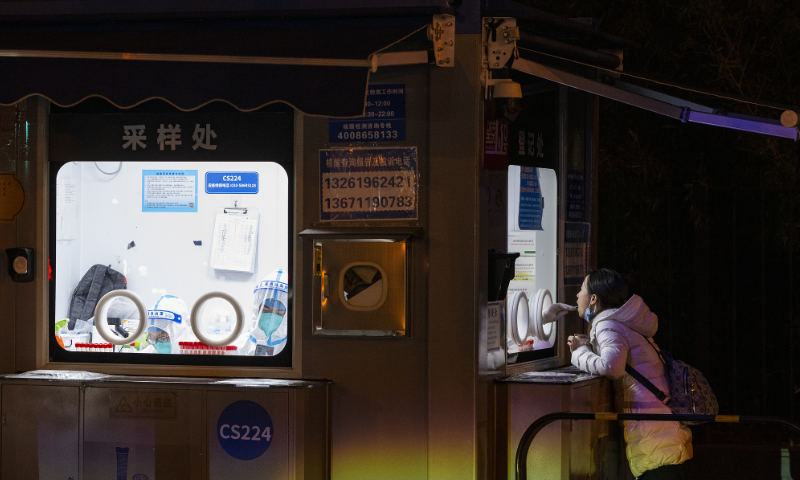
The photo taken on November 15, 2022 shows a nucleic acid testing site in Chaoyang district, Beijing. Photo: VCG
With more than 1,000 new COVID-19 infections per day in Beijing over the past two days, Beijing's COVID-19 fight has reached its most critical point, the Chinese capital's health officials said at a news conference on Wednesday.
Given the seriousness of the outbreak, Beijing has once again asked residents to reduce their movements around the city. Starting Thursday, residents must have a negative nucleic acid test certificate obtained within 48 hours in order to enter public venues in Beijing, taking the place of the current "72-hour" requirement.
In addition, the Xinguozhan Makeshift Hospital, located in the suburbs of Beijing, is now in operation. The hospital will be used to treat COVID-19 patients with milder symptoms.
Chaoyang district, which is undergoing the severest outbreak among Beijing's regions, is asking residents to stay in the community as much as possible, while residents in Fengtai district are beginning to take self-tests.
The number of new infections in Beijing continues to grow at a fast level, with the number of new infections exceeding 1,000 for two consecutive days and a fluctuating rise in social cases, with the capital's prevention and control work at the most critical and toughest moment, Beijing municipal government spokesperson Xu Hejian said at the press conference.
From 12 am to 3 pm Wednesday, Beijing reported 913 cases of domestically transmitted COVID-19 infections, including 765 cases of people under isolation and observation, and 148 cases of people screened in the communities.
Of the 913 cases, 352 cases were reported in Chaoyang district, including 71 cases at the community level.
Yang Beibei, deputy mayor of Chaoyang district, said that Chaoyang is facing its toughest challenge in its COVID-19 fight, and the risk of the epidemic spreading at the community level still exists. The district will continue to strengthen preventive and control measures at the community level, further reduce the movement of people, and lower the companies' attendance rate.
Residents of Chaoyang district are asked not to leave their neighborhoods unless there is a need, and to take nucleic acid testing near their homes.
In addition to the epidemic prevention and control measures, Chaoyang is also committed to providing full coverage of residents' needs and minimizing the impact of epidemic prevention and control on people's daily lives.
Chaoyang district has coordinated with 149 supermarkets and more than 3,500 outlets to strengthen the supply of essential goods and strengthen the reserve of "white list" transporters to ensure the capacity of supplies. As many as possible medical institutions in the district will also be open to ensure access to medical care, Yang said.
At the same time, some Beijing communities have started to pilot self-testing. On Wednesday, at least two communities in Beijing's Fengtai district notified residents through an official online platform that the communities have launched a pilot for nucleic acid self-testing, according to public information.
"Testing myself at home makes me feel safer," a Fengtai resident surnamed Zhao told the Global Times on Wednesday after taking the self-test. "There will be no more mixing of samples resulting in re-testing. And since you don't have to line up outside, it also reduces the risk of gathering and infection during testing."
However, she also noted that the self-testing is slower than the usual nucleic acid tests and is difficult for the elderly to do by themselves.
"I think the public nucleic acid testing sites in the community should still be kept, considering that some residents may not be comfortable doing it on their own," Zhao said. "However, self-testing could be a good way to share the pressure of community nucleic acid testing."




